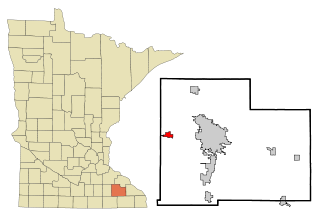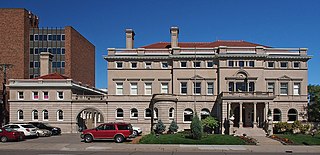
Byron is a city in Olmsted County, Minnesota, United States, approximately five miles (8 km) west of Rochester on U.S. Route 14. It is surrounded by Kalmar Township. The population was 6,312 at the 2020 census.

The Minnesota Orchestra is an American orchestra based in Minneapolis, Minnesota. Founded originally as the Minneapolis Symphony Orchestra in 1903, the Minnesota Orchestra plays most of its concerts at Minneapolis's Orchestra Hall.

Orchestra Hall, located on 11th Street at Peavey Plaza, between Nicollet Mall and Marquette Avenue in downtown Minneapolis, Minnesota, United States, is home to the Minnesota Orchestra. It is a major landmark of the southern portion of Nicollet Mall and home to many events throughout the year, in addition to being the Orchestra's home.
Reed Eliot Slatkin was an initial investor and co-founder of EarthLink and the perpetrator of one of the largest Ponzi schemes in the United States since that conducted by Charles Ponzi himself.

The American Swedish Institute (ASI) is a museum and cultural center in the Phillips West neighborhood of Minneapolis, Minnesota, United States. The organization is dedicated to the preservation and study of the historic role Sweden and Swedish Americans have played in US culture and history. The museum complex includes the Swan Turnblad Mansion, completed in 1908, and the adjoining Nelson Cultural Center, completed in 2012.

Rand Tower is a 26-story high rise in Minneapolis, Minnesota, United States, that was one of the city's tallest structures when it was completed in 1929.

The Peavey–Haglin Experimental Concrete Grain Elevator is the world's first known cylindrical concrete grain elevator. It was built from 1899 to 1900 in St. Louis Park, Minnesota, United States, as an experiment to prove the design was viable. It was an improvement on wooden elevators that were continually at risk for catching fire or even exploding. Its cylindrical concrete design became the industry standard in the United States, revolutionizing grain storage practices. After its initial experiments, the Peavey–Haglin Elevator was never again used to store grain. Since the late 1960s it has been maintained on the grounds of the Nordic Ware company and is painted with their name and logo.
Stuart Alan "Stu" Voigt is a former American football player. He played tight end for 11 seasons with the Minnesota Vikings of the National Football League.

Nordic Ware is a company based in the Minneapolis, Minnesota, suburb of St. Louis Park, notable for introducing the Bundt cake pan in the early 1950s.
Irwin L. Jacobs was an American businessman. He was the CEO of several large corporations, formerly including the now-bankrupt Genmar Holdings, boat-building company. He earned the nickname "Irv the Liquidator" for his aggressive business practices in the 1970s and early 1980s. In 1973, Jacobs founded COMB, a catalog-based mail-order retailer. In 1986, COMB and several cable television operators created the Cable Value Network (CVN), a pioneering television shopping channel which was later purchased by Joseph Segel's QVC. Jacobs, based in Minneapolis, became wealthy by taking big stakes in Fortune 500 conglomerates, usually to unlock value by breaking them up.

The Anne C. and Frank B. Semple House is a historic house in the Stevens Square/Loring Heights neighborhood of Minneapolis, Minnesota, United States. It is located on the same block as the George R. Newell House and the George W. and Nancy B. Van Dusen House. The house was listed on the National Register of Historic Places in 1998.
Petters Group Worldwide was an American diversified company based in Minnetonka, Minnesota that was turned into a $3.65 billion Ponzi scheme by its founder and CEO, Tom Petters. It had 3,200 employees and investments or full ownership in 60 companies, of which it actively managed 20, with offices in North America, South America, Asia, and Europe. Among its assets were Sun Country Airlines, Petters Warehouse Direct, and the remnants of Polaroid. Petters Group Worldwide had $2.3 billion in revenue in 2007.
Thomas Joseph Petters is a former American businessman and chairman and CEO of Petters Group Worldwide, a company which stole over 2 billion dollars in a Ponzi scheme. He was convicted of massive business fraud in 2009 and is now imprisoned at the United States Penitentiary, Leavenworth. Amid mounting criminal investigations, Petters resigned as his company's CEO on September 29, 2008. He was convicted of numerous federal crimes for operating Petters Group Worldwide as a $3.65 billion Ponzi scheme and received a 50-year federal sentence.

Cambria (keɪm-bri-ə) is a producer of engineered quartz surfaces in the United States. It is located in Le Sueur, Minnesota, with additional facilities throughout the United States, and in Ontario, Canada. Cambria is privately held and owned by the Davis family.
Ry-Krisp is an American brand of rye crisp bread that was introduced in 1899. Based in Minneapolis, Minnesota, the Ry-Krisp plant was purchased by Ralston Purina in 1926. In 1994, the Ralston portion of Ralston Purina was spun off into a new company called Ralcorp Holdings, including the RyKrisp operations. Ralcorp was acquired by ConAgra Foods in 2013.

George Washington Van Dusen was from a New York family; his father, Laurence, was born in Byron Center, Genesee County, New York. Van Dusen was a grain dealer; one of many businessmen to become very rich from the milling boom in Minnesota during the second half of the 19th century.
The Harrington Mansion and Events Center is a historic property located at 2540 Park Avenue in Minneapolis, Minnesota, United States. The estate was built in 1902 for the family of Charles Harrington, who oversaw the Minneapolis office for the Van Dusen-Harrington Company, which specialized in grain processing and distribution.

Peavey Plaza is a public outdoor event space in downtown Minneapolis, Minnesota at the south end of Nicollet Mall between South 11th and 12th Streets. The sunken plaza and its amphitheater were designed by landscape architect M. Paul Friedberg and built in 1975 alongside Orchestra Hall. The Cultural Landscape Foundation has deemed the plaza a "marvel of modernism" and it has been named one of the top ten most endangered historical sites in Minnesota.













